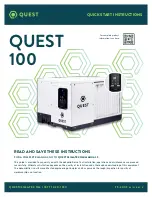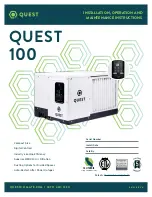
EPD 50 | EPD 70
EN
26
www.eberg.eu
leakfree disconnect couplings and in good condition. Before using the recovery machine, check thai il is in
satisfactory working order, has been properly maintained and thai any associated electrical components
are sealed to prevent ignition in the event of a refrigerant release. Consult manufacturer if in doubt.
The recovered refrigerant shall be returned to the refrigerant supplier in the correct recovery cylinder, and
the relevant Waste Transfer Note arranged. Do not mix refrigerants in recovery units and especially not in
cylinders. lf compressors or compressor oils are to be removed, ensure that they have been evacuated to
an acceptable level to make certain thai flammable refrigerant does not remain within the lubricant. The
evacuation process shall be carried out prior to returning the compressor to the suppliers. Only electric
heating to the compressor body shall be employed to accelerate this process. When oil is drained from
a system, il shall be carried out safely.
COMPETENCE OF SERVICE PERSONNEL GENERAL
Special training additional to usual refrigerating equipment repair procedures is required when equip-
ment with flammable refrigerants is affected. In many countries, this training is carried out by national
training organisations that are accredited to teach the relevant national competency standards that may
be set in legislation. The achieved competence should be documented by a certificate.
TRAINING
The training should include the substance of the following:
• Information about the explosion potential of flammable refrigerants to show that flammables may be
dangerous when handled without care.
• Information about potential ignition sources, especially those that are not obvious, such as lighters, light
switches, vacuum cleaners, electric heaters.
• Information about the different safety concepts: Unventilated – (see Clause GG.2)
Safety of the appliance does not depend on ventilation of the housing. Switching off the appliance or
opening of the housing has no significant effect on the safety. Nevertheless, it is possible that leaking
refrigerant may accumulate inside the enclosure and flammable atmosphere will be released when the
enclosure is opened. Ventilated enclosure – (see Clause GG.4)
Safety of the appliance depends on ventilation of the housing. Switching off the appliance or opening of
the enclosure has a significant effect on the safety. Care should be taken to ensure a sufficient ventilation
before. Ventilated room – (see Clause GG.5)
• Safety of the appliance depends on the ventilation of the room. Switching off the appliance or opening
of the housing has no significant effect on the safety. The ventilation of the room shall not be switched
off during repair procedures.
• Information about the concept of sealed components and sealed enclosures according to IEC 60079-
15:2010.
• Information about the correct working procedures:
a) Commissioning
• Ensure that the floor area is sufficient for the refrigerant charge or that the ventilation duct is assembled
in a correct manner.
• Connect the pipes and carry out a leak test before charging with refrigerant.
• Check safety equipment before putting into service.
b) Maintenance
• Portable equipment shall be repaired outside or in a workshop specially equipped for servicing units
with flammable refrigerants.
• Ensure sufficient ventilation at the repair place.
• Be aware that malfunction of the equipment may be caused by refrigerant loss and a refrigerant leak is
possible.
• Discharge capacitors in a way that won’t cause any spark. The standard procedure to short circuit the
capacitor terminals usually creates sparks.














































